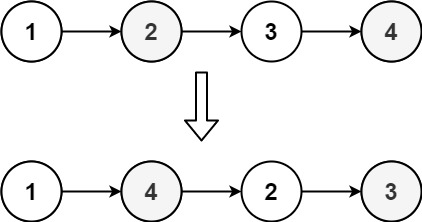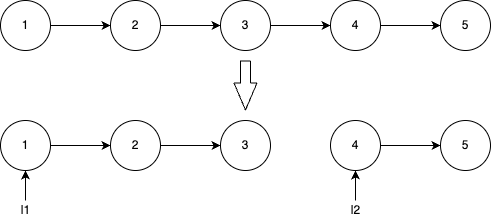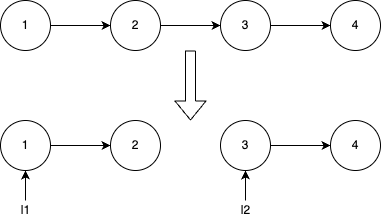 重排链表
重排链表
题目链接: https://leetcode.cn/problems/reorder-list/
视频题解: https://www.bilibili.com/video/BV1tx4y1t7YB/
# LeetCode 143. 重排链表
# 题目描述
给定一个单链表 L 的头节点 head ,单链表 L 表示为:
L0 → L1 → … → Ln-1 → Ln
请将其重新排列后变为:
L0 → Ln → L1 → Ln - 1 → L2 → Ln - 2 → …
不能只是单纯的改变节点内部的值,而是需要实际的进行节点交换。
举个例子:

输入:head = [1,2,3,4]
输出:[1,4,2,3]
# 视频讲解
建议大家点击视频跳转到b站重排链表 (opens new window)观看,体验更佳!
# 思路解析
本题如果是重排数组,可以定义两个指针left,right。一个指向数组的头,一个指向数组的尾,访问完两个元素后同时移动两个指针++left,--right,直到left >= right。但是单向链表是没办法逆序遍历的,所以我们需要把链表基于中间节点截成两部分l1和l2,对第二部分l2进行反转,然后交替合并l1和l2。
反转链表在「LeetCode 206.反转链表」中已经详细讲解过,本题的关键其实就是怎样把链表一分为二。
- 如果链表节点数为奇数

- 如果链表节点数为偶数

上面的两种情况均可通过下面的算法来实现:
- 定义两个指针
slow = head,fast = head->next。 - 当
fast且fast->next不为空,slow走一步,fast走两步。 - 当
fast或fast->next为空,slow指向的节点就是第一部分的尾节点,slow->next指向的节点就是第二部分的头节点。
在纸上模拟一遍上面的算法,可以帮助大家快速理解。
# C++代码
/**
* Definition for singly-linked list.
* struct ListNode {
* int val;
* ListNode *next;
* ListNode() : val(0), next(nullptr) {}
* ListNode(int x) : val(x), next(nullptr) {}
* ListNode(int x, ListNode *next) : val(x), next(next) {}
* };
*/
class Solution {
public:
void reorderList(ListNode* head) {
ListNode* slow = head;
ListNode* fast = head->next;
while (fast && fast->next) {
slow = slow->next;
fast = fast->next->next;
}
//反转后半段链表
ListNode* second = reverseList(slow->next);
slow->next = nullptr;
ListNode* first = head;
//交替合并first和second
while (second) {
ListNode* tmpNode1 = first->next;
ListNode* tmpNode2 = second->next;
first->next = second;
second->next = tmpNode1;
first = tmpNode1;
second = tmpNode2;
}
}
ListNode* reverseList(ListNode* head) {
if (!head)
return head;
ListNode* pre = nullptr;
ListNode* cur = head;
while (cur) {
ListNode* tmpNext = cur->next;
cur->next = pre;
pre = cur;
cur = tmpNext;
}
return pre;
}
};
# java代码
/**
* Definition for singly-linked list.
* public class ListNode {
* int val;
* ListNode next;
* ListNode() {}
* ListNode(int val) { this.val = val; }
* ListNode(int val, ListNode next) { this.val = val; this.next = next; }
* }
*/
class Solution {
public void reorderList(ListNode head) {
ListNode slow = head;
ListNode fast = head.next;
while (fast != null && fast.next != null) {
slow = slow.next;
fast = fast.next.next;
}
// 反转后半段链表
ListNode second = reverseList(slow.next);
slow.next = null;
ListNode first = head;
// 交替合并first和second
while (second != null) {
ListNode tmpNode1 = first.next;
ListNode tmpNode2 = second.next;
first.next = second;
second.next = tmpNode1;
first = tmpNode1;
second = tmpNode2;
}
}
private ListNode reverseList(ListNode head) {
if (head == null)
return head;
ListNode pre = null;
ListNode cur = head;
while (cur != null) {
ListNode tmpNext = cur.next;
cur.next = pre;
pre = cur;
cur = tmpNext;
}
return pre;
}
}
# python代码
# Definition for singly-linked list.
# class ListNode:
# def __init__(self, val=0, next=None):
# self.val = val
# self.next = next
class Solution:
def reorderList(self, head: Optional[ListNode]) -> None:
"""
Do not return anything, modify head in-place instead.
"""
slow = head
fast = head.next
while fast and fast.next:
slow = slow.next
fast = fast.next.next
# 反转后半段链表
second = self.reverseList(slow.next)
slow.next = None
first = head
# 交替合并first和second
while second:
tmpNode1 = first.next
tmpNode2 = second.next
first.next = second
second.next = tmpNode1
first = tmpNode1
second = tmpNode2
def reverseList(self, head):
if not head:
return head
pre = None
cur = head
while cur:
tmpNext = cur.next
cur.next = pre
pre = cur
cur = tmpNext
return pre
# 复杂度分析
时间复杂度: 需要遍历3次链表,所以时间复杂度为O(n),其中n为链表的长度。
空间复杂度: 只使用了几个指针,所以空间复杂度为O(1)。
上次更新: 2024/07/28, 17:12:00
